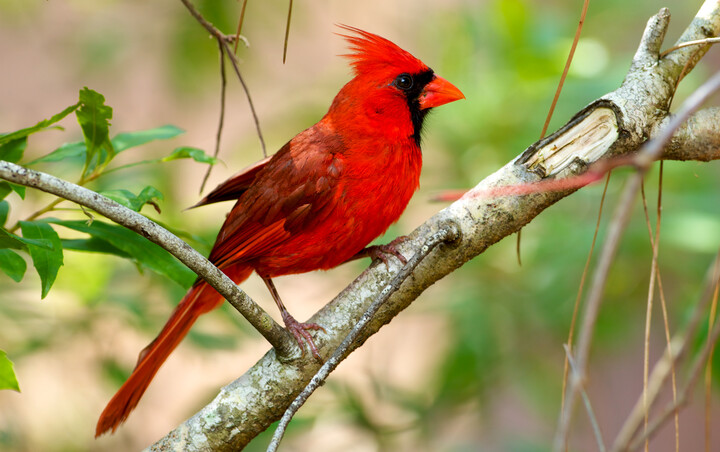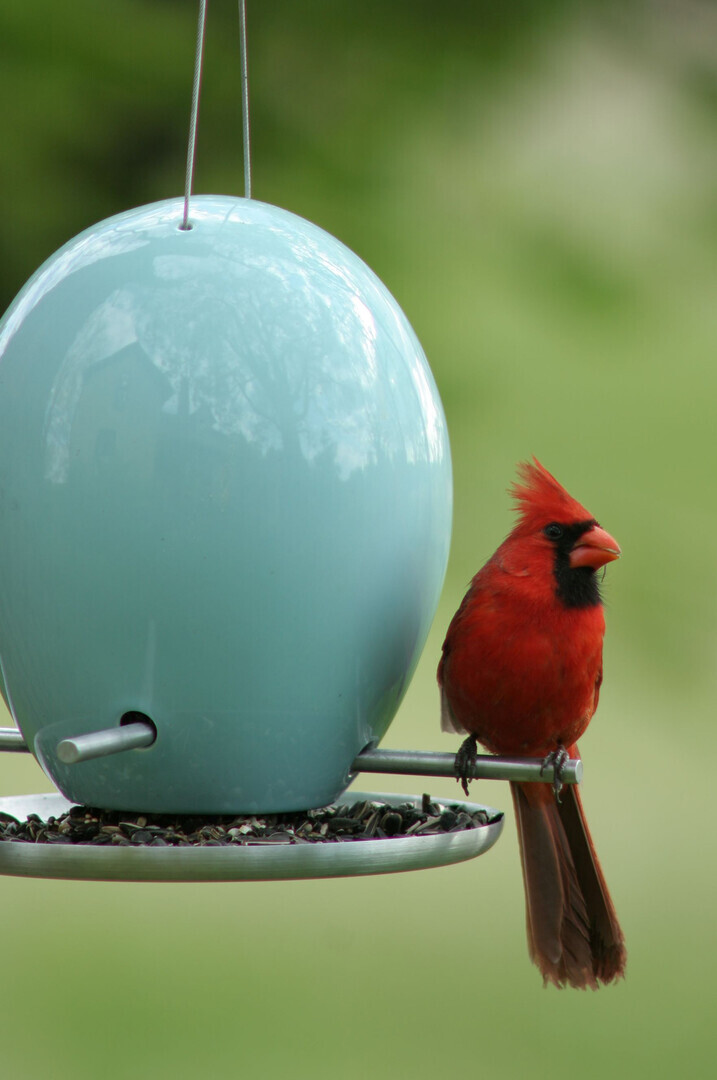Upgrade your landscaping to welcome these colorful songbirds year-round.
It's always a thrill when wild birds visit your garden, and cardinals are one of the easiest to recognize when you catch a glimpse of one perched outside your window. The males’ bright red plumage makes them stand out wherever they go. Both males and females sport jaunty top-hat-like crests and sing cheerful melodies. Cardinals are at home in most rural and suburban areas across North America, and they don’t migrate so you can expect to see them year-round. With a few cardinal-friendly landscaping tips, you can invite these common but beautiful songbirds to take up residence in your yard.
1. Plant Cardinals' Favorite Trees and Shrubs
Cardinals are voracious seed eaters. While they are frequent feeder visitors, they gather most of their food from nature. Plant some of their favorite seed sources to encourage them to forage in your landscape year-round. Native trees and shrubs are always a good bet when you want to attract local birds. Some of the cardinals’ favorite trees include mulberry, serviceberry, flowering dogwood, crabapple, and spruce. Shrubs at the top of their feeding list include staghorn sumac, red-osier dogwood, gray dogwood, and viburnum species.

2. Add Layers to Your Landscape
Dense, twiggy shrubs often serve as nesting sites for cardinals. Their four-layer nests consist of a twig frame covered by a leafy mat which is lined with bark, and finally grasses. These mini masterpieces take 3-9 days to build. A variety of shrubs will provide a good mix of materials the active birds need to construct a home. In addition to plants that lose their leaves in the fall, make sure to include a few evergreen shrubs and trees, which the birds prefer in winter. Cluster several of these shrubs together near the edges of your property to create an inviting habitat. When you choose shrubs that are food sources for cardinals, you can double the benefit.

3. Include a Water Source
Like all backyard songbirds, cardinals are attracted to water (preferably moving water). Build your own bird bath and add a small solar-powered fountain ($15, Walmart) to keep the water moving, or purchase one that has a built-in fountain. The moving water will also discourage mosquitoes from laying eggs in the water, but birdbaths should be cleaned and replenished with fresh water every few days anyway. A simple bird bath heater ($29, Chewy) will keep the water from freezing solid in cold winter areas.
4. Hang a Bird Feeder
When it comes to the type of bird feeder, cardinals aren't choosy. A platform feeder ($13, The Home Depot) makes way for easy bird watching while a tube feeder ($15, The Home Depot) is easy to fill and clean. Use your favorite feeder but take cues from ornithologists (bird experts) about what food to place in the feeder. Studies have found that cardinals are most attracted to black oil sunflower seeds ($12, The Home Depot). Cardinals also like to eat hulled sunflower seeds, safflower, cracked corn, and peanut hearts.
A word of caution: cardinals are relatively slow fliers because of their larger bodies and short, rounded wings. When they're on the ground picking up fallen seeds from feeders, they make easy prey for cats so it's best to keep your felines indoors. And try to locate feeders away from shrubs and other vegetation where cats and other predators could hide.
5. Encourage Caterpillars
While cardinals eat seeds and other plant parts (they've been known to eat the spring flowers of forsythia and redbud) most of the year, their diet shifts to more protein-rich insects during breeding season in the summer. When chicks hatch, their parents mostly feed them soft caterpillars. You can make it easier on the birds by adding plenty of caterpillar host plants, such as dill, fennel, parsley, coneflowers, and milkweed, to your container plantings and garden beds. Caterpillars will munch a few leaves on the host plants, but cardinals will find them before any major damage happens. If you don't want to add plants to your garden, the next best thing you can do is avoid using pesticides that kill caterpillars; instead, think of these insect larvae as essential food for cardinal chicks and many other backyard birds.

6. Let Perennials Stand Through Winter
Dried seed heads and foliage create foraging ground for cardinals in winter. It’s not uncommon to see a flock of several dozen cardinals in winter. While they typically forage solo or in pairs during the breeding season, winter brings the birds together in flocks. A large stand of perennials, combined with nearby shrubs, will create a valuable food and shelter source for the flock.
7. Provide Perches
Male cardinals regularly sing from perches high in trees. For smaller landscapes, choose trees with a columnar or narrow shape such as arborvitae. These trees will grow up more than they grow out, providing places for cardinals to sing without encroaching on nearby plants or structures. Fun fact: Only a few female North American songbirds sing but the female northern cardinal does, and often while sitting on the nest. Scientists believe her songs may share information with her mate about when to bring food to the nest.